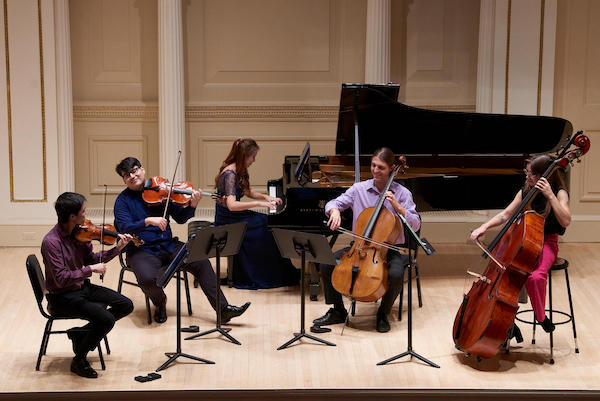Ensemble Connect’s new class brings personality-plus playing to varied program

Approaching Carnegie Hall on Monday evening, it came as no surprise to see a line stretching along the block and sold-out plastered across the marquees announcing the Broadway star Lea Michele’s concert. It was, however, a welcome jolt to be met by the same at the entrance to Weill Recital Hall for Ensemble Connect’s first concert of the season.
Then again, this is not your average group of chamber musicians. This was the debut concert for the new class of players embarking on the adventure that is Ensemble Connect. Founded in 2007, the program is a joint endeavor sponsored by Carnegie Hall and The Juilliard School. It prepares the young musicians for multi-faceted careers which span teaching, community engagement, advocacy and entrepreneurship, in addition to performing. The musicians also partner with instrumental teachers in public schools in all five of New York’s five boroughs.
One of the hallmarks of an Ensemble Connect concert is the diversity of its repertoire, which includes both works by past masters, as well as composers of today. The other is fresh, exciting performances charged with creativity, energy and daring. Monday’s program of works by Missy Mazzoli, Samuel Barber, and Franz Schubert also had the twin virtues of displaying the talents of the individual players as well as their cohesion as an ensemble.
Mazzoli composed Still Life with Avalanche in 2009. She writes that it is “a piece about finding beauty in chaos and vise versa.” The havoc of which she wrote was the sudden death of a relative, which is reflected in the work’s sudden change of course from complexity and exuberance to a far more reflective mood with sparser musical textures. The music is an exemplar of what Mazzoli described as an instance of real life working its way into music.
Still Life with Avalanche was performed by flutist Catherine Boyack, clarinetist Yasmina Spiegelberg, percussionist Oliver Xu, pianist Chelsea Wang, violinist David Bernat, and cellist Frankie Karr. The sound of another instrument adds an unusual sonority to the work’s musical texture, that of the harmonica, which was played primarily by Xu, although Bernet and Speigelberg also joined in on regular, toy-sized ones here and there.
In introducing the work, Xu described Still Life with Avalanche as the musical depiction of joy, shock and grief, which the players expressed with equal beauty and emotion. The ensemble played the ebullient opening section with rhythmic precision, which ceased with the sound of sighs from the violin and cello. The most fascinating and haunting sounds, however, came from the harmonicas expressing loss and sadness in haunting, hollow murmurs in the closing measures.
Samuel Barber composed Summer Music in 1955. It is one of the composer’s handful of chamber works and among his best known. As in Knoxville: Summer of 1915, Barber captured the indolence of a lazy summer afternoon in the opening measures, which quickly yielded to vivd depictions of both the season’s bustle and its more subtle delights, including the flickering of fireflies in the twilight.
Boyack and Spiegelberg returned on stage with oboist Joseph Jordan, bassoonist Marty Tung, and hornist Ryan Dresen to perform the Barber. The joys of this performance were the solo turns for the various instruments which revealed not only the players’ virtuosity, but also their personalities. The latter is part of what makes these concerts so enjoyable with Drysan and Jordan particularly characterful. The work ended with a whiff of sound that was as refreshing as a summer breeze.
The final work was Schubert’s beloved “Trout” Quintet. Like the other two works on the program, it too was composed on commission, but all but forgotten until after the composer’s death. Just a short while later, it was being hailed as masterpiece. At the heart of the quintet is the fourth movement with its wonderful variations on “Die Forelle,” the Schubert song from which the quintet takes its name.
This Schubert performance also provided ample opportunity for the individual players to shine, and the players did just that, comprised of Bernat, Carr, and Wang, as well as violist Ramón Carrero-Martinez and bassist Marguerite Cox. Bernat made the famous melody sing on the violin, as did Carr on the cello. Cox, in particular, grabbed the limelight with her stylish and witty bass playing.
Ensemble Connect’s next concert is at The Juilliard School on November 16. carnegiehall.org